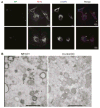Biodegradable, polymer encapsulated, metal oxide particles for MRI-based cell tracking
- PMID: 24753150
- PMCID: PMC4336226
- DOI: 10.1002/mrm.25263
Biodegradable, polymer encapsulated, metal oxide particles for MRI-based cell tracking
Abstract
Metallic particles have shaped the use of magnetic resonance imaging (MRI) for molecular and cellular imaging. Although these particles have generally been developed for extracellular residence, either as blood pool contrast agents or targeted contrast agents, the coopted use of these particles for intracellular labeling has grown over the last 20 years. Coincident with this growth has been the development of metal oxide particles specifically intended for intracellular residence, and innovations in the nature of the metallic core. One promising nanoparticle construct for MRI-based cell tracking is polymer encapsulated metal oxide nanoparticles. Rather than a polymer coated metal oxide nanocrystal of the core: shell type, polymer encapsulated metal oxide nanoparticles cluster many nanocrystals within a polymer matrix. This nanoparticle composite more efficiently packages inorganic nanocrystals, affording the ability to label cells with more inorganic material. Further, for magnetic nanocrystals, the clustering of multiple magnetic nanocrystals within a single nanoparticle enhances r2 and r2* relaxivity. Methods for fabricating polymer encapsulated metal oxide nanoparticles are facile, yielding both varied compositions and synthetic approaches. This review presents a brief history into the use of metal oxide particles for MRI-based cell tracking and details the development and use of biodegradable, polymer encapsulated, metal oxide nanoparticles and microparticles for MRI-based cell tracking.
Keywords: MRI; particles; stem cells; iron oxide; polymer.
© 2014 Wiley Periodicals, Inc.
Figures











References
-
- Bloch F, Hansen WW, Packard M. The Nuclear Induction Experiment. Physical Review. 1946;70(7–8):474–485.
-
- Bloembergen N, Purcell EM, Pound RV. Relaxation Effects in Nuclear Magnetic Resonance Absorption. Physical Review. 1948;73(7):679–712.
-
- Lauterbur PC. Image Formation by Induced Local Interactions - Examples Employing Nuclear Magnetic-Resonance. Nature. 1973;242(5394):190–191. - PubMed
-
- Lauterbur PC. Progress in n.m.r zeugmatography imaging. Philos Trans R Soc Lond B Biol Sci. 1980;289(1037):483–487. - PubMed
-
- Ohgushi M, Nagayama K, Wada A. Dextran-magnetite: a new relaxation reagent and its application to T2 measurements in gel systems. J Magn Reson. 1978;29:599–601.
Publication types
MeSH terms
Substances
Grants and funding
LinkOut - more resources
Full Text Sources
Other Literature Sources
Medical

